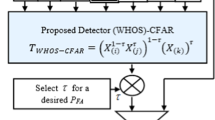Abstract
Refractivity from clutter (RFC) technique estimates lower atmospheric refractivity from radar sea clutter returns. An important issue of RFC is how to make the estimate more robust. Rather than using only single beam radar sea clutter returns, this paper puts forward a theoretical framework of combining multi-source clutter power to improve the retrieved results by the variational adjoint approach. The derivation of the adjoint is accomplished by an analytical transformation of the parabolic equation model in a continuous domain. To test the theoretical algorithm, numerical simulations using multi-elevation clutter observations are carried. The results demonstrate that combining two elevation beams gives more stable estimate than using only single beam.




Similar content being viewed by others
References
Anderson KD (1995) Radar detection of low-altitude targets in a maritime environment. IEEE Trans Antennas Propag 43:609–613
Skolnik MI (2008) Radar handbook. McGraw-Hill, New York
Baynton HW (1965) Profiles of refractive index and humidity over the west indies. Mon Weather Rev 93:171–174
Babin SM, Rowland JR (1992) Observation of a strong surface radar duct using helicopter acquired fine-scale radio refractivity measurements. Geophys Res Lett 19:917–920
Mentes SS, Kaymaz Z (2007) Investigation of surface duct conditions over Istanbul, Turkey. J Appl Meteorol Clim 46:318–337
Zhao XF, Wang DX, Huang SX et al (2013) Statistical estimations of atmospheric duct over the South China Sea and the Tropical Eastern Indian Ocean. Chin Sci Bull 58:2794–2797
Zhu M, Atkinson BW (2005) Simulated climatology of atmospheric ducts over the Persian Gulf. Boundary-Layer Meteorol 115:433–452
Haack T, Wang C, Garrett S et al (2010) Mesoscale modeling of boundary layer refractivity and atmospheric ducting. J Appl Meteorol Clim 49:2437–2457
Rogers LT, Hattan CP, Stapleton JK (2000) Estimating evaporation duct heights from radar sea echo. Radio Sci 35:955–966
Gerstoft P, Rogers LT, Krolik JL et al (2003) Inversion for refractivity parameters from radar sea clutter. Radio Sci. doi:10.1029/2002RS002640
Gerstoft P, Rogers LT, Hodgkiss WS et al (2003) Refractivity estimation using multiple elevation angles. IEEE J Oceanic Eng 28:513–525
Kraut S, Anderson RH, Krolik JL (2004) A generalized Karhunen-Loeve basis for efficient estimation of tropospheric refractivity using radar clutter. IEEE Trans Signal Proces 52:48–60
Yardim C, Gerstoft P, Hodgkiss WS (2006) Estimation of radio refractivity from radar clutter using Bayesian Monte Carlo analysis. IEEE Trans Antennas Propag 54:1318–1327
Yardim C, Gerstoft P, Hodgkiss WS (2007) Statistical maritime radar duct estimation using hybrid genetic algorithm-Markov chain Monte Carlo method. Radio Sci. doi:10.1029/2006RS003561
Yardim C, Gerstoft P, Hodgkiss WS (2008) Tracking refractivity from clutter using Kalman and particle filters. IEEE Trans Antennas Propag 56:1058–1070
Huang SX, Zhao XF, Sheng Z (2009) Refractivity estimation from radar sea clutter. Chin Phys B 18:5084–5090
Douvenot R, Fabbro V, Gerstoft P et al (2010) Real time refractivity from clutter using a best fit approach improved with physical information. Radio Sci. doi:10.1029/2009RS004137
Zhang JP, Wu ZS, Hu RX (2011) Combined estimation of low-altitude radio refractivity based on sea clutters from multiple shipboard radars. J Electromagn Waves Appl 25:1201–1212
Zhang JP, Wu ZS, Zhang YS et al (2012) Evaporation duct retrieval using changes in radar sea clutter power versus receiving height. Prog Electromagn Res 126:555–571
Karimian A, Yardim C, Gerstoft P et al (2012) Estimation of radio refractivity using a multiple angle clutter model. Radio Sci. doi:10.1029/2011RS004701
Zhao XF, Huang SX, Wang DX (2012) Using particle filter to track horizontal variations of atmospheric duct structure from radar sea clutter. Atmos Meas Tech 5:2859–2866
Karimian A, Yardim C, Gerstoft P et al (2011) Refractivity estimation from sea clutter: an invited review. Radio Sci. doi:10.1029/2011RS004818
Zhao XF, Huang SX (2012) Estimation of atmospheric duct structure using radar sea clutter. J Atmos Sci 69:2808–2818
Kuttler JR, Dockery GD (1991) Theoretical description of the parabolic approximation/Fourier split-step method of representing electromagnetic propagation in the troposphere. Radio Sci 26:381–393
Barrios AE (1992) Parabolic equation modeling in horizontally inhomogeneous environments. IEEE Trans Antennas Propag 40:791–797
Brekhovskikh LM, Lysanov YP (2002) Fundamentals of ocean acoustics. AIP Press, New York
Engl HW, Hanke M, Neubauer A (1996) Regularization of inverse problems. Kluwer Academic Publishers, London
Zhu C, Byrd RH, Lu P et al (1995) L-BFGS-B Fortran subroutines for large-scale bound constrained optimization. Northwestern University EECS Tech. Rep. NAM12
Acknowledgments
The authors thank Prof. Peter Gerstoft at the Marine Physical Laboratory, University of California, San Diego, for helpful discussions about RFC problem. The refractivity data used in this paper are acquired from Prof. Peter Gerstoft’s software package SAGA. This work was supported by the National Natural Science Foundation of China (41175025) and the National Basic Research Program of China (2011CB403500).
Conflict of Interest
The authors declare that they have no conflict of interest.
Author information
Authors and Affiliations
Corresponding author
About this article
Cite this article
Zhao, X., Wang, D. & Huang, S. Atmospheric duct estimation from multi-source radar sea clutter returns: theoretical framework and preliminary numerical results. Chin. Sci. Bull. 59, 4899–4906 (2014). https://doi.org/10.1007/s11434-014-0428-x
Received:
Accepted:
Published:
Issue Date:
DOI: https://doi.org/10.1007/s11434-014-0428-x




